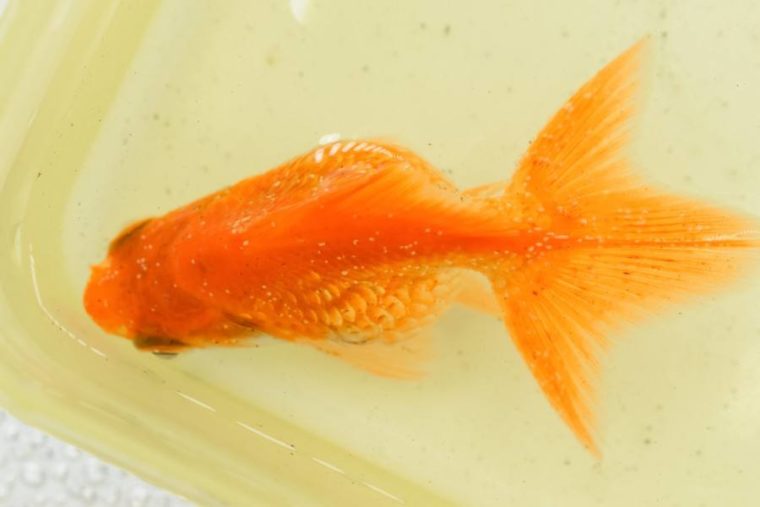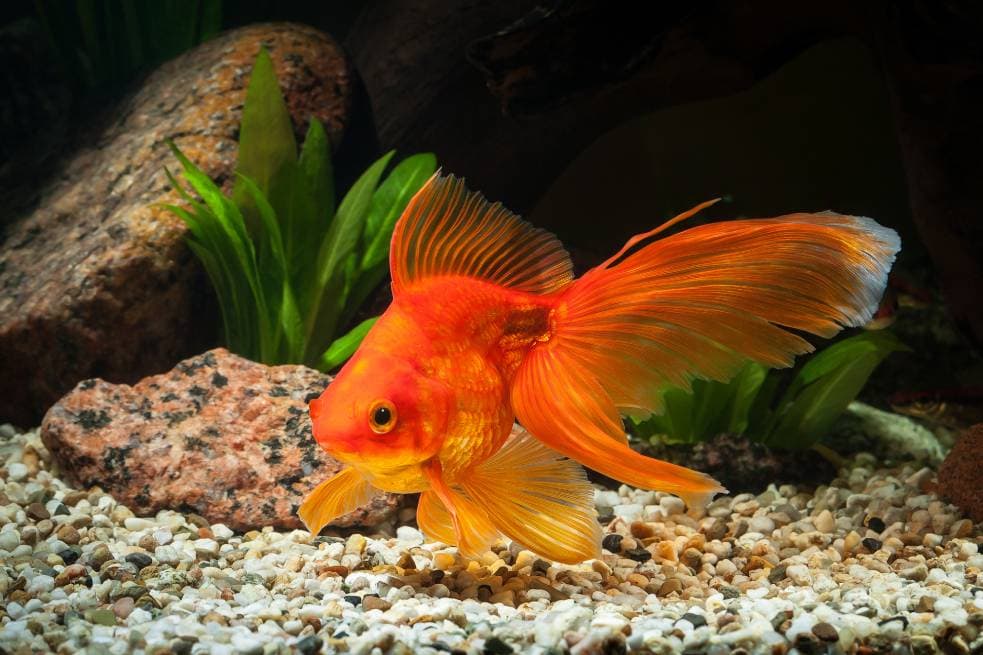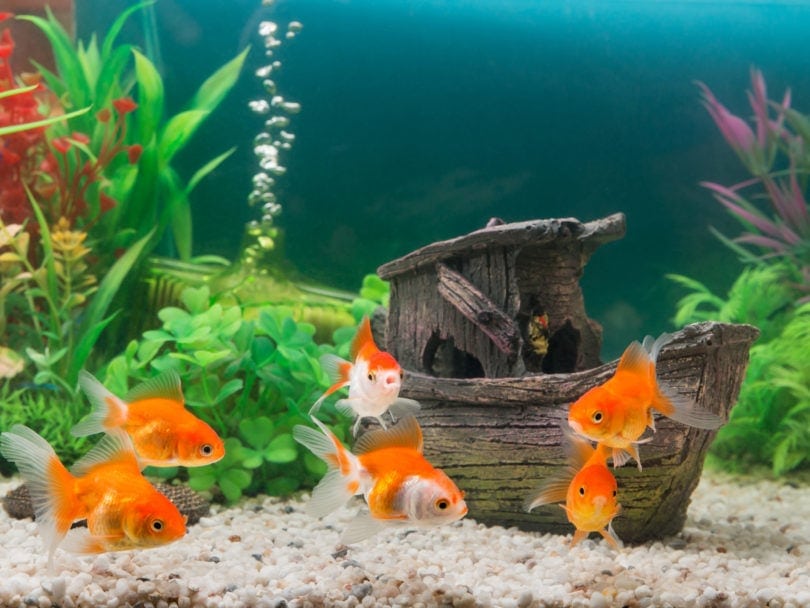
The Watonai goldfish is a rare breed of fancy goldfish that was created as a cross between the humped-back Ryukin and the popular fantail Wakin goldfish. This is a Japanese-bred goldfish that was first described in 1908. They are unique because the Watonai goldfish has the body of a Koi fish with a long and flowy double tail.
This is a beautiful breed of fancy goldfish and there is a lot of interesting information to know about them, so read on below for more!
 Quick Facts about Watonai Goldfish
Quick Facts about Watonai Goldfish
| Species Name: | Carassius auratus |
| Family: | Cyprinidae |
| Care Level: | Intermediate |
| Temperature: | 57°–78° Fahrenheit |
| Temperament: | Docile |
| Color Form: | Bicolor, tricolor, sarasa, calico |
| Lifespan: | 15 years |
| Size: | 10–12 inches |
| Diet: | Omnivore |
| Minimum Tank Size: | 40-gallon horizontal aquariums |
| Tank Set-Up: | Freshwater pond or large aquarium |
| Compatibility: | Other fancy goldfish and koi |
Watonai Goldfish Overview
The Watonai goldfish is a beautiful and rare goldfish breed that has recently been rebred into captivity after being extinct for a short period. Older variations of this goldfish breed were discovered more than a hundred years ago and were proudly bred to have a streamlined body and a long flowing tail that spans the size of its body length.
Due to one of these breed’s ancestors thriving in outdoor ponds (the Wakin), the Watonai is hardy and can adapt to living outdoors much like the popular pond fish called Koi. Descendants of the Watonai were believed to have disappeared from captivity somewhere around the middle of the 20th century and only recently has this breed resurfaced after a group of dedicated breeders decided to bring the Watonai back due to its beauty, popularity, and ability to thrive in cold conditions—unlike many other delicate breeds of fancy goldfish.
They are fairly easy to care for which is what makes them such a popular breed of goldfish in Japan. Aside from the Watonai goldfish’s striking appearance, they have a good temperament and hardiness that allows them to thrive in otherwise unfavorable conditions.
How Much Do Watonai Goldfish Cost?
Since the Watonai is rare and has only recently been bought back into the market thanks to goldfish enthusiasts, the Watonai goldfish can be quite an expensive goldfish to purchase. The average cost for a Watonai goldfish can be from $60 to $200. The price varies according to the quality of the Watonai goldfish, its size, and if it has any defaults, such as a kinked tail or imperfect body shape that breeders would sell for less if they do not choose to cull the goldfish.
Typical Behavior & Temperament
The Watonai goldfish can be described as peaceful and social. They move slowly through the water and rarely cause trouble with their tank mates. These fish are curious and enjoy exploring their ponds or large aquariums searching for food and grouping with other goldfish.
Watonai goldfish tend to uproot live plants in planted aquariums. This can cause a mess to the substrate and any decorations in the aquarium, which is why some Watonai goldfish owners will keep these goldfish in bare tanks with large plants that are weighted down by rocks and thick layers of gravel. Digging seems to be part of this goldfish breeds curious nature.
Appearance & Varieties
Watonai goldfish are admired for their beautiful appearance which many Japanese breeders take pride in. This goldfish grows fairly large (up to 10–12 inches in size) which is why they need such a large aquarium or pond to thrive. When viewed from above, the Watonai has a butterfly shape as their long tails span from their body and flow in the water. It is not uncommon for old and well-cared-for Wantonai goldfish to reach a maximum size of 18 inches in length, especially if they are kept in very big ponds and are fed a high-quality diet.
Watonai goldfish have a double-finned tail that is nearly as long as their body, with lush and vibrant coloration. These goldfish typically come in a few different colors such as black, deep orange, white, red, and commonly a combination of two or more colors. They also come in the tricolor, bicolor, sarasa, or calico varieties.
How to Take Care of Watonai Goldfish
Habitat, Tank Conditions & Setup
Tank Size
Watonai goldfish are large fish (spanning 10–18 inches in length) which means that they should live in a relatively large volume of water. Like most goldfish, the Watonai should be placed in the biggest tank possible, but usually, ponds are more suitable for this breed of goldfish.
The absolute minimum tank size for a Watonai goldfish is 40 gallons, but this is only suitable for very small and young Watonai. They will grow and thrive better in larger tanks and ponds, so keep that in mind when choosing the right tank for this goldfish breed.

Water Quality & Conditions
Watonai goldfish should live in freshwater conditions with a stable temperature, although this breed is tolerant of cold water conditions. The water quality in their pond or aquarium should be clean and have the following parameters:
Substrate
Watonai goldfish are not fussy with the type of substrate in their aquarium, and gravel, sand, or bare bottom ponds and tanks will suffice. This breed seems to enjoy foraging in the substrate, so you do not want to place them in an aquarium or pond with large pieces of gravel as they might choke on it. Sand is a good choice of substrate for Watonai goldfish.
Plants
As previously mentioned, this goldfish breed tends to uproot plants in an aquarium which can become a problem if you want to keep them in a beautiful, planted aquarium with live plants. Plants are not a necessity for this goldfish breed, but they may enjoy taking cover under the plants to feel more secure. There is also the bonus that live plants help improve the water quality by absorbing excess nutrients in the water produced by the fish’s waste.
Lighting
Like most goldfish, Watonai does not need bright lighting in their aquarium, and they might even become inactive when exposed to sudden bright lights. Low to moderate natural or artificial lighting will work for this goldfish breed. If you have them in a pond, also make sure a large portion of the pond is shaded away from harsh sunlight so that these goldfish do not experience rapid temperature fluctuations.
Filtration
These are big goldfish that produce a lot of waste, so a filter is an essential item that should form part of the aquarium or pond they are kept in. Watonai goldfish produce a lot of waste so filters that have more than two types of filtration(either mechanical, biological, or chemical) will be beneficial in keeping the water quality within optimal conditions while removing debris that would cloud and dirty the aquarium water.
Understanding the intricacies of water filtration can be tricky, so if you're a new or even experienced goldfish owner who wants a bit more detailed information on it, we recommend that you check out Amazon for the best-selling book, The Truth About Goldfish.
It covers all you need to know about creating the most ideal tank setup, goldfish care, and more!
Are Watonai Goldfish Good Tank Mates?
For the most part, Watonai goldfish make good and peaceful tank mates. These goldfish do not usually bully other fish and they can cohabit well with other large fancy goldfish and large invertebrates such as apple or mystery snails. The main reason Watonai goldfish should be kept with other breeds of fancy goldfish is that these types of goldfish are slow-moving much like the Watonai. You want to avoid keeping Watonai with fast-moving single-tailed goldfish as this can cause the two breeds to fight over food, mainly because single-tailed goldfish swim faster than Watonai and get to the food first.
Koi are also acceptable tank mates for this breed of goldfish if they are both similar in size. Koi can grow large very quickly and should live in ponds, so an adult Watonai can make a good tank mate.
It is not recommended to keep Watonai with tropical fish or aggressive species of fish because they have different care, tank size, and water temperature requirements than Watonai.
What to Feed Your Watonai Goldfish
Watonai goldfish should be fed a balanced and varied diet that is suited for goldfish and contains both plant and animal protein matter since these goldfish are omnivores. A high-quality sinking pellet will make a good staple food for this goldfish breed, and they can be supplemented with foods such as blanched vegetables, deshelled peas, tubifex worms, or freeze-dried invertebrates and worms as a treat. Pelleted foods or pre-mixes of gel goldfish foods are a better choice than goldfish flakes that easily dissolve in the water, not only leading to poorer water quality but also losing the flake’s nutrients faster in comparison to other foods.
Keeping Your Watonai Goldfish Healthy
It is fairly easy to keep these goldfish healthy and thriving. The most important factor to consider if you want to successfully grow and raise Watonai goldfish is to first make sure that they are in a large aquarium or pond. A Watonai will do better in a large aquarium versus a bowl. They grow large and their aquarium should be able to support their growth rate and maximum size.
The next factor to consider is the water quality that these goldfish will be living in. Clean and filtered water with plenty of aeration will keep your Watonai healthy and reduce the risk of them falling ill.
The last factor to consider is their diet, which should consist of a good amount of protein, fiber, and fat to fuel their energy levels while providing them with all the vitamins and minerals they require to stay healthy.
Breeding
Once the Watonai has matured, the males will begin to chase the females around the tank during the breeding season to show that they are interested in mating. This will encourage the female Watonai to release eggs that will then be fertilized by the male Watonai. At times these behaviors can become rough, and females may be injured by the male’s constant nudging and chasing, so it is a good idea to keep an eye on male and female pairs during breeding seasons.
Most Watonai goldfish breeders take care of breeding two healthy adults with no defaults so that the offspring are more likely to be healthy and grow to be a better version of their parents in terms of appearance.
 Are Watonai Goldfish Suitable for Your Aquarium?
Are Watonai Goldfish Suitable for Your Aquarium?
The fascinating and beautiful Watonai goldfish is guaranteed to capture the hearts of enthusiastic goldfish keepers. This goldfish breed is best suited for goldfish keepers that have a large pond or aquarium that can support the maximum size of an adult Watonai and their tank mates. It is important to note that although most Watonai goldfish are small in size when first purchased, as they begin to grow and develop, they can reach a really large size which makes it difficult for the average goldfish owner to keep up with.
If you are to provide your Watonai with a suitably sized home, excellent water quality, and a good diet, then this goldfish breed will thrive in your care.
- Related Read: Wakin Goldfish
Featured Image Credit: Zay Nyi Nyi, Shutterstock

 Quick Facts about Watonai Goldfish
Quick Facts about Watonai Goldfish








